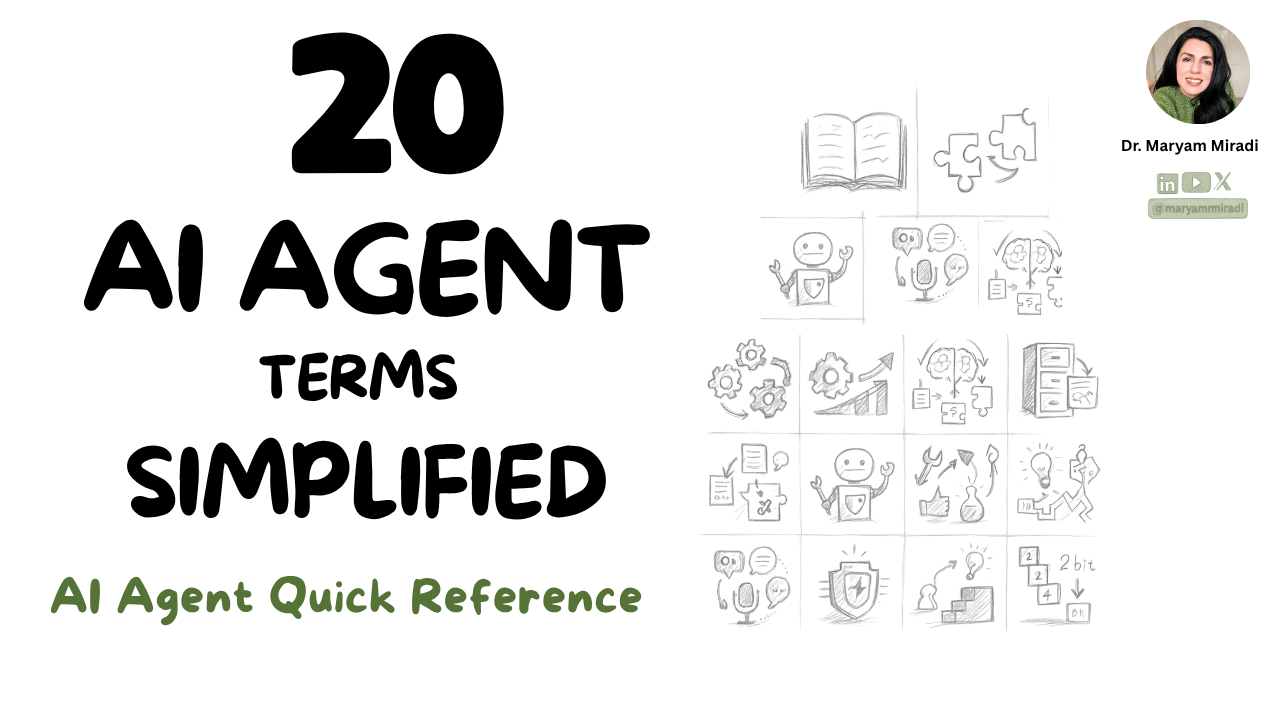20 AI Agent Terms Simplified - AI Agent Quick Reference
Nov 13, 2025
𝗧𝗵𝗲𝘀𝗲 𝟮𝟬 𝘁𝗲𝗿𝗺𝘀 𝗺𝗮𝗸𝗲 𝗲𝘃𝗲𝗿𝘆 𝗳𝘂𝘁𝘂𝗿𝗲 𝗽𝗼𝘀𝘁 𝗼𝗻 𝗔𝗜 𝗔𝗴𝗲𝗻𝘁𝘀 𝗶𝗻𝘀𝘁𝗮𝗻𝘁𝗹𝘆 𝗰𝗹𝗲𝗮𝗿 𝗮𝗻𝗱 𝗺𝗲𝗮𝗻𝗶𝗻𝗴𝗳𝘂𝗹.
Problem: When your engineer says "agent," your PM thinks "autonomous system," and your CEO thinks "chatbot."
That misalignment?
It's killing your AI initiatives.
After 20+ years applying AI across industries and teaching AI Agents Mastery globally, I've watched miscommunication destroy more projects than bad code ever could.
The solution?
A shared vocabulary.
𝗜 𝘀𝘂𝗺𝗺𝗮𝗿𝗶𝘇𝗲𝗱 𝟮𝟬 𝗲𝘀𝘀𝗲𝗻𝘁𝗶𝗮𝗹 𝘁𝗲𝗿𝗺𝘀 ▼
》 𝗙𝗼𝘂𝗻𝗱𝗮𝘁𝗶𝗼𝗻 𝗟𝗮𝘆𝗲𝗿
✸ 1. Large Language Models
Neural networks trained to predict the next token
✸ 2.Tokenization
Breaking text into discrete meaningful units for processing
✸ 3. Vectorization
Mapping meaning into numerical coordinates in high-dimensional space
✸ 4. Attention
Disambiguating context by examining nearby words
》 𝗧𝗿𝗮𝗶𝗻𝗶𝗻𝗴 & 𝗢𝗽𝘁𝗶𝗺𝗶𝘇𝗮𝘁𝗶𝗼𝗻
✸ 5. Self-Supervised Learning
Scaling training without human-labeled examples
✸ 6. Transformers
Stacking attention & feedforward layers for deep understanding
✸ 7. Fine-tuning
Specializing base models for specific domains and use cases
✸ 8. Reinforcement Learning
Optimizing model behavior through feedback and rewards
》 𝗣𝗿𝗼𝗱𝘂𝗰𝘁𝗶𝗼𝗻 𝗘𝗻𝗴𝗶𝗻𝗲𝗲𝗿𝗶𝗻𝗴
✸ 9. Few-shot Prompting
Adding example inputs and outputs inline for better responses
✸ 10. Retrieval Augmented Generation (RAG)
Fetching relevant context on-demand from external sources
✸ 11. Vector Databases
Enabling fast semantic search for contextually relevant documents
✸ 12. Context Engineering
Managing long conversations, history, and user preferences strategically
》 𝗔𝗱𝘃𝗮𝗻𝗰𝗲𝗱 𝗖𝗮𝗽𝗮𝗯𝗶𝗹𝗶𝘁𝗶𝗲𝘀
✸13. Model Context Protocol (MCP)
Connecting LLMs with external systems and real-time data sources
✸ 14. Agents
Orchestrating multi-step autonomous tasks across systems
✸ 15. Chain of Thought
Breaking down reasoning into explicit step-by-step processes
✸ 16. Reasoning Models
Adapting complexity and steps dynamically based on problem difficulty
》 𝗘𝗳𝗳𝗶𝗰𝗶𝗲𝗻𝗰𝘆 & 𝗦𝗰𝗮𝗹𝗲
✸ 17. Multi-modal Models ☆ Processing and generating text, images, video, and audio
✸18. Small Language Models (SLM)
Specializing efficiently with 3-300M parameters for specific tasks
✸ 19. Distillation
Compressing teacher model knowledge into smaller student models
✸ 20. Quantization
Reducing memory and inference costs by lowering numerical precision
Now All Terms explained simply:
1. Large Language Models (LLM) A neural network trained to predict the next token in an input sequence by learning patterns from vast amounts of text data.
2. Tokenization The process of breaking input text into discrete meaningful units (words, subwords, or character combinations) that the model can process.
3. Vectorization Converting tokens into numerical coordinates in high-dimensional space where semantically similar words are positioned close together, enabling the model to understand meaning mathematically.
4. Attention A mechanism that determines contextual meaning by examining nearby words in a sentence, allowing the model to disambiguate terms like 'apple' (fruit vs. company) based on surrounding context.
5. Self-Supervised Learning A training approach where the model learns from the inherent structure of data itself (like predicting masked words) without requiring human-labeled examples, making training highly scalable.
6. Transformer A specific neural network architecture using stacked attention and feedforward layers to process input tokens and predict outputs, serving as the engine behind most modern LLMs.
7. Fine-tuning The process of taking a pre-trained base model and training it further on specific question-answer pairs or domain data to make it respond in desired ways for particular use cases.
8. Few-shot Prompting Supplying a prompt with examples alongside a query, helping it understand the expected response format and improve output quality.
9. Retrieval Augmented Generation (RAG) Enhancing model responses by fetching relevant documents from external sources (like company policies) and including them as context alongside the user's query.
10. Vector Database A specialized database that stores documents as vectors and enables fast similarity searches to retrieve contextually relevant information for incoming queries.
11. Model Context Protocol (MCP) A standardized protocol allowing LLMs to connect with external servers and databases to access real-time information and execute actions beyond their training data.
12. Context Engineering The practice of strategically managing and optimizing all context sent to an LLM, including chat history, summarizations, user preferences, retrieved documents, and external data sources.
13. AI Agents Long-running processes that can autonomously query LLMs, access external systems, and coordinate with other agents to accomplish complex multi-step tasks based on user requirements.
14. Reinforcement Learning A training technique where models learn optimal behaviors by receiving positive scores for good responses and negative scores for bad ones, gradually improving through trial and feedback.
15. Chain of Thought A reasoning approach where models are trained to break down problems step-by-step and explain their thinking process, leading to higher quality responses for complex queries.
16. Reasoning Models Advanced models that can dynamically determine how many reasoning steps are needed to solve a problem, adjusting their approach based on problem complexity (examples: OpenAI o3, DeepSeek).
17. Multi-modal Models Models capable of processing and generating multiple types of data (text, images, video, audio) rather than being limited to text alone, offering richer understanding and capabilities.
18. Small Language Models (SLM) Compact models with 3-300 million parameters (versus billions in LLMs) trained on specific company or task data, offering faster inference and lower costs for specialized use cases.
19. Distillation The process of training a smaller "student" model to mimic a larger "teacher" model's outputs, compressing knowledge into fewer parameters while maintaining reasonable performance at lower computational cost.
20. Quantization A compression technique that reduces the numerical precision of model weights (e.g., from 32-bit to 8-bit numbers), significantly decreasing memory requirements and inference costs in production environments.
----------------------------
🎓 New to AI Agents? Start with my free training and learn the fundamentals of building production-ready agents with LangGraph, CrewAI, and modern frameworks. 👉 Get Free Training
🚀 Ready to Master AI Agents? Join AI Agents Mastery and learn to build enterprise-grade multi-agent systems with 20+ years of real-world AI experience. 👉 Join 5-in-1 AI Agents Mastery
⭐⭐⭐⭐⭐ (5/5) 1500+ enrolled
👩💻 Written by Dr. Maryam Miradi
CEO & Chief AI Scientist
I train STEM professionals to master real-world AI Agents.



